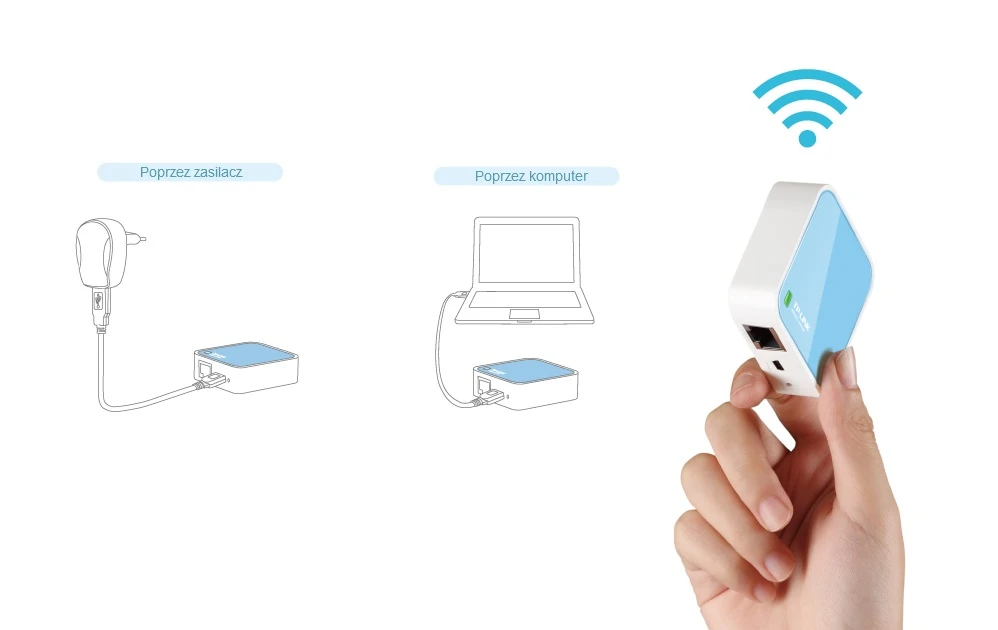TP-Link TL-WR702N | WiFi Router | 2,4GHz, 1x RJ45 100Mb/s, 1x micro USB

TP-Link TL-WR702N is the smallest wireless router with very simple operation. It is designed for use with tablets, smartphones, portable game consoles and other portable wireless devices. The device allows a convenient connection to the Internet with a connection speed up to 150 Mbps. Thanks to its small size, it is ideal for use on the road and is powerful enough to support almost all basic wireless applications.

TL-WR702N is the smallest wireless router with very simple operation. Simply plug it into an outlet in your hotel room and enter a password to create a wireless hotspot in no time at all.

The TL-WR702N has a USB-B port and can be powered by an external power supply unit or a USB cable connection to a computer. All you need to do on the go is connect the TL-WR702N to your computer's USB port or car charger to share the wireless connection with family and friends.

The TL-WR702N supports AP, Router, Bridge, Client and Repeater operating modes, allowing different wireless applications to provide users with more dynamic and complex wireless operations. In addition, for the highest level of user security, the router supports WEP, WPA/WPA2 and WPA-PSK/WPA2-PSK encryption.

| Features / filters | |
| Wireless network standards | IEEE 802.11b, IEEE 802.11g, IEEE 802.11n, |
| Equipment features | |
| Ports | 1 port 10/100Mb/s WAN/LAN 1 micro-USB port Reset button |
| Wireless standards | IEEE 802.11n, IEEE 802.11g, IEEE 802.11b |
| Dimensions (S x G x W) | 57 x 57 x 18 mm (2.2 x 2.2 x 0.7 inches) |
| Antenna type | Built-in |
| Wireless transmission characteristics | |
| Frequency of operation | 2.4-2.4835GHz |
| Transmission speed | 11n: up to 150Mbps (dynamic) 11g: up to 54Mb/s(dynamic) 11b: up to 11Mb/s(dynamic) |
| Receiver sensitivity | 135M:-70dBm@10%PER 65M:-73dBm@10%PER 54M:-76dBm@10%PER |
| EIRP | CE: <20dBm(2.4GHz) FCC: <30dBm |
| Wireless modes of operation | AP, router, client, repeater, bridge |
| Wireless transmission functions | Wireless transmitter on/off, WDS bridge, WMM, wireless connection statistics |
| Wireless transmission security | 64/128/152 bit WEP, WPA/WPA2, WPA-PSK/WPA2-PSK |
| Software functions | |
| Quality of Service function | WMM, capacity control |
| WAN | Dynamic IP/Static IP/PPPoE/ PPTP/L2TP |
| Management | Access control Local governance Remote management |
| DHCP | Server, client, DHCP client list, address reservation |
| Port forwarding | Virtual Server, Port Triggering, UPnP, DMZ |
| Dynamic DNS | DynDns, Comexe, NO-IP |
| VPN Pass-Through | PPTP, L2TP, IPSec (ESP Head) |
| Access control | Management panel access control, host list, access schedule, access rule management |
| Firewall protections | Protection against DoS attacks, SPI firewall, IP, MAC and domain filtering, IP and MAC address binding |
| Other | |
| Certificates | CE, FCC, RoHS |
| Package contents | Router TL-WR702N Power supply USB cable Ethernet cable Quick Installation Guide CD |
| System requirements | Microsoft® Windows® 98SE, NT, 2000, XP, Vista™ or Windows 7, MAC® OS, NetWare®, UNIX® or Linux |
| Working environment | Permissible operating temperature: 0℃~40℃ (32℉~104℉) Permissible storage temperature: -40℃~70℃ (-40℉~158℉) Permissible air humidity: 10%~90% non-condensing Permissible storage humidity: 5%~95% non-condensing |
| TP-Link WR702N - User Manual | Download |
A hard reset will restore the unit to its factory default settings. You should reconfigure the device from scratch or you can load a configuration file that you have backed up before resetting.
For these models we could see the WPS / RESET button on the rear panel / front panel. To use the WPS function, press the button for less than 5 seconds, then the WPS LED will start flashing; to reset the router, press the button for at least 10 seconds.
There are two methods of resetting to the factory settings of the router:
Method 1 : Hard reset / pressing the RESET button
When the router is on, press and hold the WPS / RESET button (longer than 10 seconds) until the SYS LED starts flashing rapidly from a slow flash. Then release the button and wait until the router restarts and returns to the factory default settings.

Method 2 : Through the router's network interface
You can see the How to login to the Wi-Fi router's web interface, then go to Advanced -> System Tools -> Backup and Restore -> Restore Factory Settings, then click -> Restore Factory Settings and wait for the router to reboot and restore to the factory default settings.
Step 1 Open the web browser window, enter the IP address of the router into the address field (default value is 192.168.1.1). Then press the Enter key.
Step 2 To log in to the device's configuration page, enter your user name and password (the default value of both fields is: admin).
Step 3
To open the Wireless Settings window, select Wireless->Wirless Settings from the left hand menu.

Step 4 Configure the wireless transmission options.
SSID: Enter a name for the wireless network.
Region: Select the country/region where the device operates.
Channel: Select the channel for wireless network.
Mode: Select the operation mode (802.11 b/g).
Enable Wireless Router Radio/Enable SSID Broadcast: These options are enabled.
Enable Wireless Security: If the network is not to be secured, do not select this option.
Step 5 To save the settings, press the Save button.
Attention, please:
If there are several wireless networks nearby, check the other channel numbers for better connection quality.
If the wireless network card supports Super G technology, the Mode router can be changed to 108Mbps Static (802.11g).
To secure your wireless network, go to the other articles below.